|
Location:
Ard�che Gorge, Nr Vallon, France. |
Grid Reference:
N 44� 21', E 4� 29' 24". |
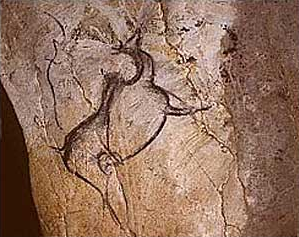
 Chauvet Pont d'Arc:
(Palaeolithic Cave-art).
Chauvet Pont d'Arc:
(Palaeolithic Cave-art).
Discovered in 1994 in the valley near France's
Ardeche River, the Chauvet Cave contains the oldest such paintings
on record (some of them 32,000 years old), almost perfectly
preserved when collapsing rocks sealed off the entrance some 25,000
years ago.
The art is the oldest recorded
cave-art in the world and is
surprisingly extensive, highly varied, and very skilfully executed,
it includes species now extinct such as the Megaceros (Right).
(Map
of the Chauvet Cave System)
|
Chauvet Cave:
(The Cave of Forgotten Dreams) |
The
Ard�che Gorges in France is often
referred to as the 'Grand Canyon' of
Europe with spectacular limestone cliffs
towering up to
1000ft
above the meandering river below. The
entrance to which is through the famous
Pont D'Arc based near Vallon which at
192ft is, according to the Natural Arch
and Bridge Society, "the largest
natural bridge in Europe". It was
here that the discovery of the Chauvet
cave was made in 1994.

The 'Pont d'Arc', a natural nearby landmark which would have been
impressive sight to the Palaeolithic residents of the gorge.
Based on radiocarbon dating, the cave appears to have been
occupied by humans during two distinct periods: the Aurignacian
and the
Gravettian.
Most of the artwork dates to the earlier, Aurignacian, era
(30,000 to 32,000 years ago). The later Gravettian occupation,
which occurred 25,000 to 27,000 years ago, left little but a
child's footprints, the charred remains of ancient hearths and
carbon smoke stains from torches that lit the caves.
Hundreds of animal paintings have been catalogued, depicting
at least 13 different species, including some rarely or never
found in other ice age paintings. Rather than depicting only the
familiar animals of the hunt that predominate in Paleolithic
cave art, i.e. horses, cattle, reindeer, etc., the walls
of the Chauvet Cave are covered with
predatory animals: lions, panthers, bears, owls, rhinos and
hyenas.
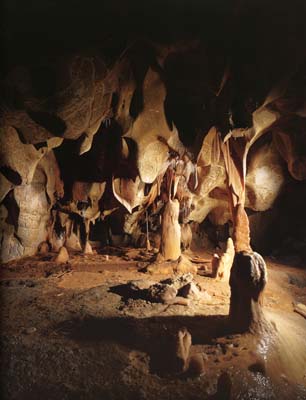 Hilaire Chamber with hanging rocks. Hilaire Chamber with hanging rocks.
The fantastical shape of
the cave would have made Chauvet a particularly 'sacred' place
through Palaeolithic eyes. The theory that such places were used for
'shamanic' purposes is still in its infancy, but do not seem to
apply in the case of Chauvet. The vast number of bones with cut
marks on them, and the discovery of a child's footprints are more
indicative of normal day-to-day living. The appearance of such high
quality art at this early time suggests that our understanding of
such processes is far from being fully understood.
Because
of near-toxic levels of radon and carbon dioxide, nobody can
stay in the cave for more than a few hours at a time
(1)
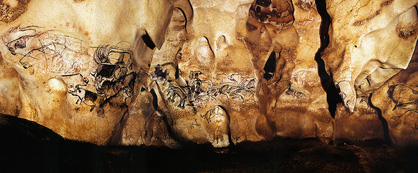
The Chauvet Cave Bears.
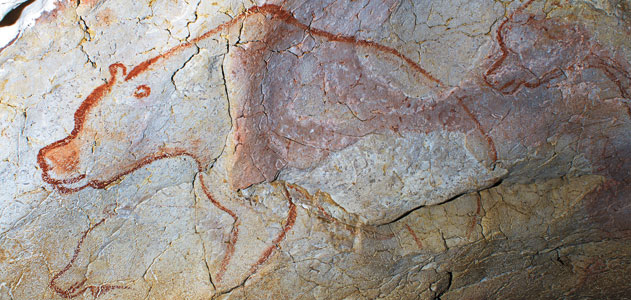
This outline of a bear is
significant in the light of the numerous bear bones, scratch marks
on the walls, indentations in the ground (for sleeping) and
footprints, all of which demonstrate that the cave was used by bears
for a long time.

This 'Altar'
stone was found with the skull of a bear on its top surface.
Although Cave-bears
are now extinct, they were clearly present when these painting were
being done as some of the bear footprints have pigment on them and
there are even claw-marks on some of the animal paintings. The
floor of the cave was found with over 150 skeletons of
cave-bears in it (2)
. The
significance of the stone above therefore is speculative, but it is
suggested
that it was placed there deliberately and therefore represents a
form of relationship between man and cave-bear.
The Chauvet 'Venus':
The last and
deepest of the Cave chambers, the Salle du Fond, is the home of the
Chauvet Venus. From the ceiling of the chamber, which is nearly 7 m
[20 feet] high, a vertical cone of limestone hangs down ending in a
point 1.10 m [3ft 6 ins] off the floor. It is on this hanging
outcrop that the Venus was drawn in black charcoal.

The black
pubic triangle of the Venus is
at eye level and seems to be the
heart of the composition. It is
shaded in with black pigment.
The white vulva slit appears to
have been done later with a
pointed tool and is clearly
indicated by a vertical line
incised strongly enough to cut
through both the black pigment
and the yellow surface film of
the rock. The legs, with plump
thighs, finish in a point with
the feet not shown. This Venus
is absolutely classical and her
proportions, the stylistic
elements, the selection of the
anatomical elements shown are
all characteristically
Aurignacian or Gravettian,
as known from the small Venus
statues of Central and Eastern
Europe.
The Venus is not isolated. Other lines
and realistic representations are
associated with her, directly on the
outcrop. Higher and to the left of the
Venus are two felines, a mammoth and a
small musk ox. To the right of the Venus
is the "Sorcerer" or man-bison. The
relation of the Venus to the Sorcerer
cannot be simply fortuitous. The Venus is the earliest of the
designs. The feline on the left,
the Sorcerer, and the multiple
lines on the right, are all
painted or engraved later. Their
creation entailed a voluntary
and selective local destruction
of parts of the body of the
Venus, the most obvious spot
being at one of the upper
extremities of the pubic
triangle.
Even more surprising is the
voluntary absence of any super
imposition. Neither the Sorcerer
nor the large feline on the left
cut across the Venus.
The Venus and the composition in which
she occupies a privileged place are in a
central topographic situation in the
Salle du Fond. However, she is
paradoxically peripheral in the over all
design that seems centred on a beautiful
horse lodged in a small chapel like
niche to the left in the middle of the
main panel of
cave paintings.
Perhaps the female representation
relates directly to the corridor to the
chamber, which opens just behind her.
Four other female representations
limited to just the pubic triangle are
in the cave; they are all in the system
including the Galerie des Megaceros and
the Salle du Fond, indicating each time
the entrance to the adjacent cavities.

"This Venus
is absolutely classical and her proportions, the stylistic elements,
the selection of the anatomical elements shown are all
characteristically Aurignacian or Gravettian, as known from the
small Venus statues of Central and Eastern Europe." - Jean Clottes,
'Return to Chauvet Cave'.
(More
about Venus Figurines)
Gallery of Images: Chauvet
Pont d'Arc.

The spectacular
panel on the walls of the 'Hillaire Chamber'. The walls were
smoothed before they were painted.
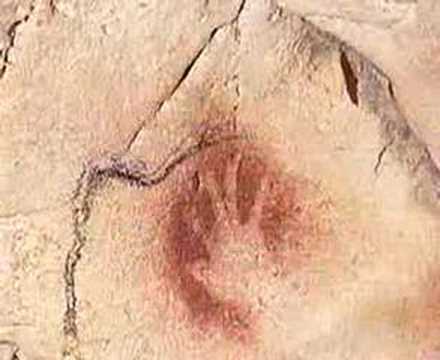
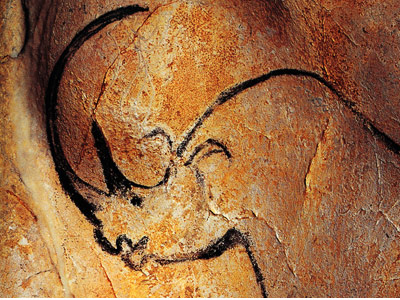
The natural outline of a horse in
rock, with hand-print (Left), and exquisite drawing of a Rhino
(Right).
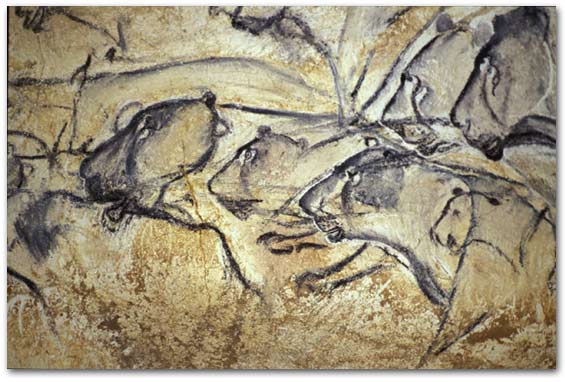
The artist has played with
perspective at the same time as capturing the feline form, look and
stance.
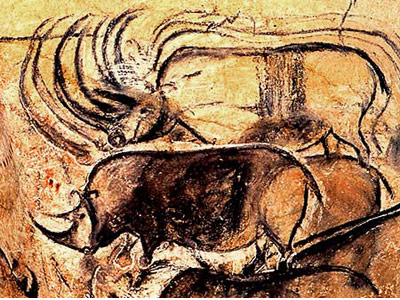

More animal groupings... of
Rhinoceros (Left), and Horses (Right)
(So accurate are the forms of the
animals one has to ask if the artist might have taken sketches down
into the cave).

Bison on a Wall
with Bear Claw-marks.
|


 Hilaire Chamber with hanging rocks.
Hilaire Chamber with hanging rocks.










